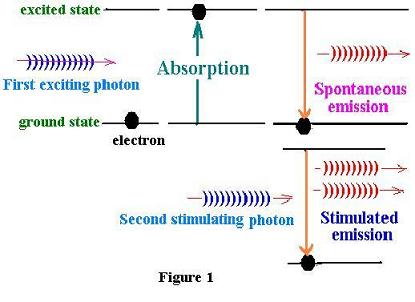|
The effects
in PHYSICS
|
|
LASERS
Let's analyse the following figure:

We have the following cases :
- A first photon excites the atom and desappears.
It had carried off excactly the necessary energy to rise
the electron from the ground sate to the excited state.
The process here the absorption.
- After some tens of nanoseconds, by itself, spontaneously,
the atom can loose the excitation when, the electron, without
any intervention, breturns back to the lower state.
This is the spontaneous emission.
- An incomming incident new photon can trigger the fall of the
electron to the ground state, then the emission of a photon.
The atom de-excites and releases a photon of the same energy as the incident photon .
In this case, we have two outcomming photons: the incident
and the emitted; (the incident photon is not absorbed by the atom).
The process here is the stimulated emission.
LASER is the acronym for Light Amplification by Stimulated Emission of Radiation.
The main process in the laser technique is then the stimulated emission.
Each incoming photon involves two photons. In their turn, ivolve four,
and so forth as in the chain reaction, that is the light is amplified.
The related stimulated photons are very special. They are charaterized
by the fact that:
The incident photon and the emitted photon are in phase, have the same
wavelength, and travel in same direction.
|
|
|

